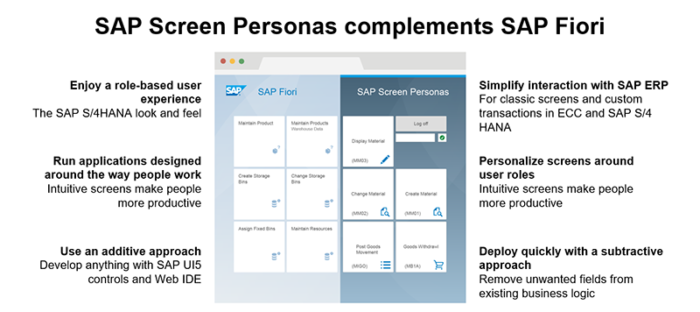your journey
Completing the SAP Fiori User Experience with SAP Screen Personas
Great article from Conrad Bernal, member of the SAP Screen Personas team at SAP.
Organisations interested in a user experience improvement project often ask whether to use SAP Screen Personas or SAP Fiori. While project requirements and resources differ, achieving a consistent SAP Fiori user experience (UX) is a question of “and”, not “or”. SAP Screen Personas complements SAP Fiori and, according to SAP’s chief design officer, Sam Yen, is one of the fastest ways to create the SAP Fiori UX.
The following diagram is meant to illustrate how SAP Screen Personas is interwoven with the SAP Fiori user experience:

How SAP Fiori (left) and SAP Screen Personas (right) contribute to the SAP Fiori user experience
SAP Screen Personas allows organisations to bring the role-based SAP Fiori experience to SAP ERP users in SAP ECC, SAP Business Suite on HANA, and SAP S/4HANA. Not only can you use it with classic transactions, you can also use it to simplify your custom Z-transactions. The difference between the technologies involves their approaches to screen design.
Using SAP Fiori, you can develop whatever you need from the ground up using SAP UI5 controls and the SAP Web IDE, for example. With SAP Screen Personas, you simplify your user experience using existing business logic: remove fields your users don’t need, automatically fetch information using the scripting engine, use the editor to bring scattered (but relevant) information onto a single screen. This subtractive approach means that screen simplification can be completed in a relatively short amount of time, with minimal development effort: many projects are carried out by business analysts, rather than developers.
Using SAP Screen Personas and SAP Fiori Together
If you’re on SAP S/4HANA and there’s an SAP Fiori app that suits your needs, use it! If you can use an SAP Fiori app with slight modification, customise it! If there’s not an SAP Fiori app and you’re working with classic and/or custom transactions, use SAP Screen Personas to fill in the gaps and create a consistent, simple experience for your end users.
Also – take a look at Creating a corporate UX Strategy
Share this:

Neil ran his first SAP transformation programme in his early twenties. He spent the next 21 years working both client side and for various consultancies running numerous SAP programmes. After successfully completing over 15 full lifecycles he took a senior leadership/board position and his work moved onto creating the same success for others.